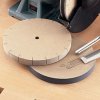Best way, IMO, is to get ahold of some carbon steel Old Hickory paring knife type deals (6.00 or so apiece), dull the heck out of them doing real tasks, and then learn to resurrect them.
The thing with sharpening a lot of steels is, even if you're doing right it takes time to see good results. If you're doing it wrong you can remove all the steel you want, and will have somewhat damaged the knife by the time you realize it's time to see good results.
Good carbon steel takes about 10-20% of the time it takes to sharpen most stainless in my experience, so you can learn what works faster. Then when you are confident, go and sharpen your stainless knives using the same technique (more in a sec on this) and be consistent and patient.
Here is the basic technique I use.
Light, slow, NOT GRINDING HARD or pressing down. Consistent angle is more important than "right angle." I err on the side of "too low." I also like thinner profile knives period because they cut better, hands down.
If you're grinding on the right side (to the right if you were holding the knife vertically, looking at the spine), check periodically, carefully, for a burr on the left side of the knife. To do this, run your thumb perpendicular to the blade, from the direction of the spine, down the bevel at about a 30-45 deg angle. You should eventually feel a consistent little sharp lip or rim forming. Incidentally some people mistake this for an edge.
When you get the burr, flip and grind backward for a few strokes to knock it back a bit, then grind normally until you get a burr on the right side. If you're moving up to a different stone, repeat the process on each side on each stone. If you are leaving it at just one stone, which is fine for most applications, grind or strop the burr off.
Burrs are different on different knives, but they serve as a decent indication that you have done it right on the opposite side of the burr and are ready to flip. One of the main keys to having a good, sharp knife with an edge that lasts is making sure it doesn't have a burr on either side when you're done sharpening. The best way to do this is to just go progressively lighter on each side of the stone, and you can eventually alternate between light single strokes. Another, easier way that works almost as well is just to lightly strop for 20-50 strokes on either side with the nappy side of a leather belt, alternating at the end.
Just remember that different steels take a different sort of burr. The hardest part about sharpening my sodbuster, which burrs after 2-3 light strokes, is getting the burr off. I've had stainless knives that didn't burr after 50 strokes. Sometimes if you sharpen that much and still no burr forms, you can go ahead and flip to the other side. Just be sure that before you are done, you have raised and ground off a burr on either side.



